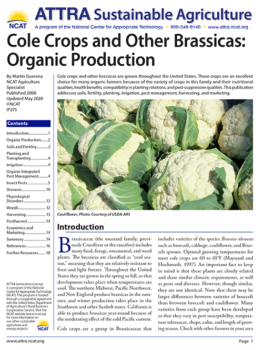Cole Crops and Other Brassicas: Organic Production
By Martin Guerena, NCAT Agriculture Specialist
Cole crops and other brassicas are grown throughout the United States. These crops are an excellent choice for many organic farmers because of the variety of crops in this family and their nutritional qualities, health benefits, compatibility in planting rotations, and pest-suppressive qualities. This publication addresses soils, fertility, planting, irrigation, pest management, harvesting, and marketing.
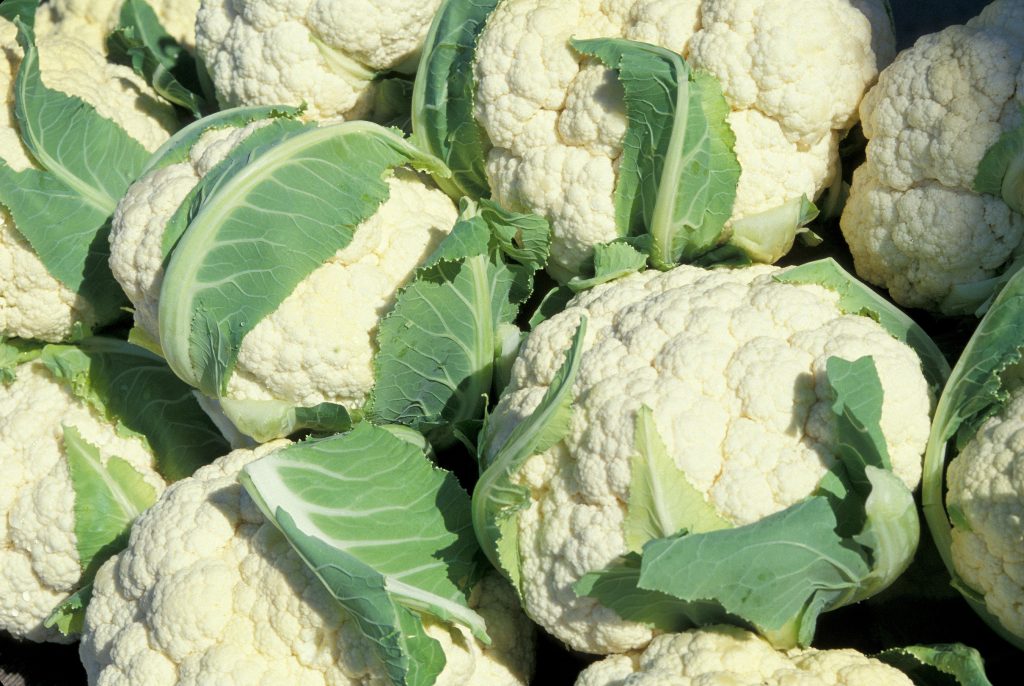
Cauliflower. Photo: Courtesy of USDA-ARS
Introduction
Brassicaceae (the mustard family, previously Cruciferae or the crucifers) includes many food, forage, ornamental, and weed plants. The brassicas are classified as “cool season,” meaning that they are relatively resistant to frost and light freezes. Throughout the United States, they are grown in the spring or fall, so that development takes place when temperatures are cool. The northern Midwest, Pacific Northwest, and New England produce brassicas in the summer, and winter production takes place in the Southwest and other Sunbelt states. California is able to produce brassicas year-round because of the moderating effect of the cold Pacific current.
Cole crops are a group in Brassicaceae that includes varieties of the species Brassica oleracea such as broccoli, cabbage, cauliflower, and Brussels sprouts. Optimal growing temperatures for most cole crops are 60 to 65°F (Maynard and Hochmuth, 1997). An important fact to keep in mind is that these plants are closely related and share similar climatic requirements, as well as pests and diseases. However, though similar, they are not identical. Note that there may be larger differences between varieties of broccoli than between broccoli and cauliflower. Many varieties from each group have been developed so that they vary in pest susceptibility, temperature tolerances, shape, color, and length of growing season. Check with other farmers in your area or your Extension agent to see which varieties are adapted to your local conditions.
The genus and species Brassica oleracea was developed in western and central Europe from wild species found in the Mediterranean region (Nieuwhof, 1969). Brassica rapa, a similar species developed in Asia, consists of turnips, Chinese cabbage, bok choi, rapini, canola, and the mustards. Other plants in Brassicaceae from other genera are: radishes (Raphanus), watercress (Nasturtium), and horseradish (Armoracia). Nutritionally, brassicas are high in carotenoids, vitamins C and A, calcium, iron, magnesium, and dietary fiber. Broccoli and broccoli-seed sprouts in particular contain high levels of antioxidant sulphoraphanes, which are anticarcinogenic compounds. Some brassicas are high in glucosinolates, chemical precursors to sulphoraphines, which form isothiocyanates in the soil (Ishida et al., 2014). This is an important consideration when designing a crop rotation strategy. Isothiocyanates are biologically active compounds that are of considerable interest to farmers because of their ability to suppress some insects, diseases, nematodes, and weeds in a process known as biosolarization. For more information on biosolarization, see ATTRA’s publication Soil Solarization and Biosolarization.
Ornamental crops in the mustard family make up about 50 genera, including Arabis, Erysimum (Cheiranthus), Hesperis, Iberis, Lobularia, Lunaria, and Matthiola (Watson and Dallwitz, 1992). The number of crops in this family, as well as their nutritional qualities, health benefits, compatibility in planting rotations, and pest-suppressive qualities, make these crops an excellent choice for many organic farmers.
Organic Production
Organic production of brassica crops—or any commodity—relies on management techniques that replenish and maintain long-term soil fertility by optimizing the soil’s biological activity. This is achieved through crop rotation, cover cropping, composting, and by using organically accepted fertilizer products that feed the soil while providing plants with nutrients. Besides producing high-quality crops, a healthy, well-balanced soil can help plants develop natural resistance to insect pests and diseases. When pest controls are needed, organic farmers manage insects, diseases, weeds, and other pests with cultural, mechanical, biological, and—as a last resort—organically accepted biorational and chemical controls.
In 2002, USDA implemented the National Organic Standards regulating organic production nationwide. All farmers and ranchers wishing to market their products as organic must be certified. An exception to this requirement is made for farmers who sell less than $5,000 annually. For more information on organic production and certification, visit ATTRA’s Organic Farming topic area.
Soil and Fertility
The brassicas are heavy feeders that can grow on a variety of soils, as long as the soils provide adequate nutrients and moisture and are well drained. The soil is where plant health begins and ends. A healthy soil will have a greater capacity to moderate the uptake of fertilizers and will allow a more balanced uptake of nutrients, creating a healthy plant that is less attractive to pests and more resistant to pest damage.
Soil components—minerals, air, water, and organic matter—vary widely depending on geography and climate. The challenge on farmland is to maintain healthy soils with adequate levels of organic matter. Healthy soils will demonstrate the following characteristics: good tilth, good habitat for numerous and diverse microorganisms, absorption and retention of water, the ability to buffer salts and pH, an “earthy smell,” resistance to erosion by either wind or water, and production of healthy crops.
Organic matter is the soil component primarily responsible for these traits. Organic matter is broken down by soil organisms, creating humus. Humus, in turn, provides nutrients to crop plants. Sustainable soil management maintains soil health and productivity by taking care of and increasing the soil’s organic matter. Cultural practices, such as the application of manures and compost, using cover crops, and rotating crops, are methods to achieve this. Healthy soil can be considered a living organism that must be nurtured in order to sustain its life and productivity.
Throughout their life cycles, brassica crops require particular nutrients in varying quantities to support optimal growth and reproduction. Nitrogen is the nutritional element that most cultivated crops need in the greatest amount. Plants use it to form proteins, chlorophyll, protoplasm, and enzymes. In cole crops, it’s most important for overall growth, and adequate amounts are necessary for best yields. Usually the initial nitrogen available from green manure or compost is enough, but, as the plant develops, it may need supplemental nitrogen, and succeeding crops may also need a nitrogen boost. Organic sources of supplemental nitrogen include guano, pelleted compost, fish emulsion, blood meal, feather meal, cottonseed meal, alfalfa meal, and kelp. They should be applied as soon as the plants are strong enough (usually at about six inches tall) to withstand the side-dressing operation. Side-dressing involves placing the fertilizer along the furrow at least six to eight inches away from plant stems to avoid fertilizer burn. The mineralization of nitrogen and its availability to plants varies greatly, depending on the nitrogen source, the temperature, humidity, texture of the material, and microbial activity. In a transitional or newly certified operation, growers should keep records of the materials they used and how the crops responded to them. Once growers learn how each material reacts to specific conditions, and as the soil’s organic matter builds, fertility management usually becomes easier.
Composted manure and cover crop residues usually provide enough phosphorus for brassicas. If additional phosphorus is needed, rock phosphate may be an option.
Potassium (potash) requirements for cole crops are high. Composted manures, composted straw and hay (especially animal bedding), granite dust, material derived from langbeinite, kelp meal, greensand (glauconite), and wood ash (if not contaminated with colored paper, plastic, or other synthetic substances) are acceptable sources of potash.
The macronutrient calcium and micronutrients boron, manganese, molybdenum, and iron are important for cole-crop development. Biologically active soils with adequate organic matter usually supply enough of these nutrients. Compost and seaweed products are sources of supplemental micronutrients. For more information on soils and fertilizers, see ATTRA’s Soils topic area.
Planting and Transplanting
Most brassicas are direct-seeded into prepared seedbeds. The optimal time to plant is when soil temperatures are between 65 and 75°F, though some varieties can germinate in soils with temperatures as low as 45°F and as high as 85°F (Lorenz and Maynard, 1980). The seedbed should be pre-irrigated or solarized to reduce potential weed problems. If the bed is seeded too closely, thinning is necessary to achieve proper spacing. Good-quality seed with a high germination percentage is important when establishing a direct-seeded stand.
Some crops that have high seed costs, long growing seasons, and special growing requirements, such as cauliflower and Brussels sprouts, are usually transplanted from greenhouses to the field. Crops like cabbage and broccoli can either be direct-seeded or transplanted, depending on conditions such as season and costs. Direct-seeding broccoli during mid-summer for a fall crop is less expensive than using transplants. During late winter, using transplanted broccoli may open a marketing window for spring production that could be economically advantageous. Transplanting can overcome some problems, such as soil crusting and high or low soil temperatures, that can cause uneven seedling emergence. Consider factors like these when choosing how to establish plants.
Growing transplants requires great experience and skill. Transplants can be purchased commercially and must be certified organic if they are used in a certified organic operation. Advantages in using transplants are uniform stand and quality, efficient use of seed, season extension, reduced weeding costs, reduced irrigation, shortened cropping period in the field, and less exposure to pests. Transplants should be free of pests, weather-hardened, and not long or leggy. Hardening is the process of gradually acclimating young greenhouse plants to the outside environment. Most transplants are hardened two weeks before planting in the field. Transplants should also be well irrigated prior to planting, so that the plants can survive until they are irrigated in the field. Also, transplanting should be done during cool weather and with minimal root disturbance, to reduce transplant shock. Transplant shock is the stress every transplant experiences while adjusting to its new environment.
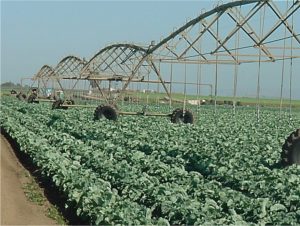
Linear or lateral-move irrigation system in broccoli. Photo: Martin Guerena, NCAT
Irrigation
Soil texture, environmental conditions, and crop age are factors to consider when irrigating any crop. Cole crops are generally shallow-rooted, with roots ranging from 18 to 24 inches long. Some exceptions to this are mustard, rutabaga, and turnips, whose roots range from 36 to 48 inches (Doneen and MacGillivray, 1943). Chinese cabbage and pak choi have shallow root systems that respond well to light, frequent irrigations (Larkcom, 1991). Essentially, the art of irrigation is applying the right amount of water to the plants so that they produce an economically viable crop. Too much water is wasteful and can cause problems with diseases and weeds. Too little water causes plants to slow their development, eventually causing stress, pest susceptibility, and lower yields. So, how much is enough?
A rule of thumb is that vegetables will need about one inch of water per week from rain or supplemental irrigation in order to grow vigorously. In arid regions, about two inches are required (Lorenz and Maynard, 1980).
Sprinkler irrigation should be used for germinating seeds and establishing transplants. Once the plants are established, furrow or drip irrigation is recommended.
Organic Integrated Pest Management
Integrated Pest Management (IPM) is a broad ecological approach to pest management using a variety of pest-control techniques that target the entire pest complex of a crop ecosystem. Integrated management of pests ensures high-quality agricultural production in a sustainable, environmentally safe, and economically sound manner (Bajwa and Kogan, 2002).
Soil health is based on soil biology, which is responsible for the cycling of nutrients. The complex interactions of this biological community are known as the soil food web. The soil ecosystem is composed of bacteria, fungi, protozoa, nematodes, algae, arthropods (insects and mites), and large soil-dwelling mammals like moles, ground squirrels, and gophers. The photosynthesizers, or primary producers in this system, use the sun’s energy to convert atmospheric carbon into sugars. Other organisms feed off these primary producers. Dead organisms and their byproducts decompose, becoming the soil’s organic matter that stores nutrients and energy. Plants use these nutrients, preventing them from accumulating in soil and water. The life cycle of all these organisms improves the condition of soils by enhancing structure, water-infiltration and water-holding capacity, and aeration. This results in healthy plants that are more productive and resistant to pests.
Another plant-protection phenomenon attributed to soil microbial activity is induced and acquired systemic resistance, in which the plant’s immune system is stimulated to resist pest attack. In one study, the soil fungus Trichoderma hamatum induced systemic resistance in cucumber against Phytophthora crown rot and leaf blight (Khan et al., 2004). The concept of healthy soils being responsible for plant health has long been known to organic farmers, and scientists are just starting to document it.
IPM is based on the following components: pest identification, monitoring, mechanical and physical controls, cultural controls, biological controls, and chemical controls.
The biological and cultural insect controls for cole crops involve understanding the ecology of agricultural systems. We invite pest problems by planting large expanses of a single, susceptible crop. When there is a diverse farmscape involving many types of plants and animals, the likelihood of severe insect pest outbreaks diminishes considerably. That is why farmers must create production methods that complement natural systems. For example, the use of beneficial insect habitats along crop field borders increases the presence of beneficial insects (Blaauw and Isaacs, 2012; Grez and Prado, 2000; White et al., 1995; Bugg, 1993). These habitats provide shelter, food (pollen and nectar), and act as refuges that attract pests’ natural enemies to fields. When purchased beneficial insects are released, these field-edge habitats will encourage the beneficials to remain and continue their life cycle there, helping to reduce pest populations. Some pests may also inhabit the field-edge habitats; therefore, these habitats should be monitored along with the crop. For additional information, see the ATTRA publication A Pictorial Guide to Hedgerow Plants for Beneficial Insects.
Insect Pests
Aphids
The cabbage aphid, Brevicoryne brassicae, is a major pest of cole crops worldwide. It is small (1/8 inch long), dark green, and exudes a gray, waxy secretion. What it lacks in size it makes up in numbers, reaching adulthood in eight to 12 days and asexually producing five to six nymphs per day for 30 days (Hines and Hutchison, 2019). Aphids pierce plants and suck their juices, distorting leaves and growing points. Large colonies infest leaves, heads, and flower stalks, making products unmarketable. Other aphids, such as the green peach aphid and turnip aphid, will feed on brassicas, but they usually do not cause economic damage.
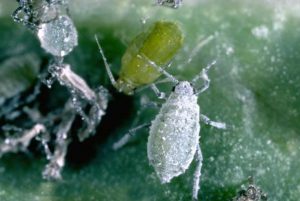
Cabbage aphid. Photo: Jack Kelly Clark, courtesy of UC Statewide IPM Program
Cabbage aphids have many natural enemies that can be attracted to fields with habitat plantings. These include syrphid flies, lacewings, and the predaceous midge (all of which produce larvae that consume aphids), minute pirate bugs, bigeyed bugs, lady beetles (the adults and larvae of which both consume aphids), soldier beetles, and parasitic wasps like Diaeretiella rapae. In some humid areas, there are outbreaks of naturally existing fungi that cause epidemics among aphid colonies. The insect-consuming fungus Beauveria bassiana, which is sold commercially as a bioinsecticide, has shown suppressive effects of three isolates on cabbage aphids in field tests in India while not affecting predatory coccinellid and spiders (Ramanujam et al., 2017). Cultural controls that reduce aphid populations include the use of sprinkler irrigation, in which water at high pressure dislodges the insects from plants. This practice may work when plants are young and cupping or when inflorescence development has not yet occurred. Broccoli and cabbage plants interplanted in clover used as a living mulch showed a reduction in aphids, compared to plants in clean cultivated fields (Costello and Altieri, 1994; Theunissen et al., 1995). Other interplanting strategies to combat cabbage aphid include the use of mustard or collards as trap crops and the use of different varieties of the same crop in sequential plantings. Cabbage aphids exhibit a preference for certain species and will also discriminate among varieties and plants of varying age (Altieri and Schmidt, 1987; Kloen and Altieri; 1990).
Nitrogen management can have an effect on aphid infestations. Studies in Great Britain showed that Brussels sprouts treated with high nitrogen (3.2 mg/g plant fresh weight) grew more rapidly than those with low nitrogen (0.64 mg/g plant fresh weight), but the improved growth with high nitrogen was offset by the increased population of aphids (Koritas and Garsed, 1984). However, too little nitrogen can also cause stress in plants and make them susceptible to insect attack.
Spraying some plant essential oils and extracts from peppermint, as well as lantana (Lantana camara), has also demonstrated some control of cabbage aphid (Baidoo and Adam 2012; Mekuaninte et al., 2011).
Organically accepted insecticides include insecticidal soap, neem, plant and mineral oils, and pyrethrum. The waxy leaf cuticle of brassicas and the white, waxy secretions of the cabbage aphid tend to repel water-based insecticides, so a spreader-sticker is recommended. Many growers use soap to overcome this problem. Water hardness will reduce the efficacy of insecticidal soap because calcium, iron, and magnesium will precipitate the fatty acids and make the soap much less effective against the insects. The best way to determine how well your water will work is to use the soap-jar test. Let a jar full of spray solution sit for 20 minutes, then look for precipitates in the soap-water solution.

Diamondback moth larva. Photo: W. L. Sterling, Dept. of Entomology, Texas A&M University
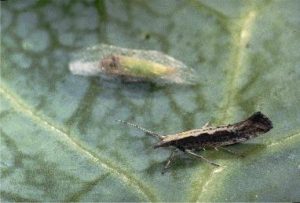
Diamondback pupae and adult. Photo: Chris Campbell, VegEdge, University of Minnesota
Caterpillar Pests
The cabbage looper (Trichoplusia ni), diamondback moth (Plutella xylostella), and imported cabbage worm (Pieris rapae) are the major caterpillar pests of cole crops. Other caterpillar pests can be regional or seasonal problems, like armyworms, cutworms, cabbage webworms, corn earworms, cross-striped cabbageworms, Gulf white cabbageworms, and southern cabbageworms.
Caterpillars have many natural enemies that help keep their populations down. Predators such as ground beetles, spiders, damsel bugs, minute pirate bugs, assassin bugs, bigeyed bugs, and lacewing larvae attack caterpillars. The parasitic wasps Trichogramma spp., Copidosoma spp., Apanteles spp., Diadegma spp., and Hyposoter spp. sting and parasitize eggs and larvae. Some of these organisms are available commercially, or they may occur naturally in the environment. For information on suppliers of beneficial insects, visit the University of Kentucky extension publication Vendors of Beneficial Organisms in North America.

Cabbage looper. Photo: W.L. Sterling, Dept. of Entomology, Texas A&M University

Cabbage looper moth. Photo: W.L. Sterling, Dept. of Entomology, Texas A&M University
Biopesticides or microbial controls consist of Bacillus thuringiensis (Bt), insect-consuming fungi, and viruses. Bt is a naturally occurring bacterium that produces a toxin that causes paralysis of a caterpillar’s digestive tract. A caterpillar may continue to live for some hours after ingestion, but will not continue to feed.
Bt degrades rapidly in sunlight and requires careful timing or repeated applications. Bt must be ingested in sufficient amounts by the caterpillar to be effective. Consequently, growers must understand the feeding habits of the pests, so that proper formulations are used and timing of applications is optimal. Caterpillars in their early stages of development (first and second instars) are more susceptible to this toxin. Older and bigger worms are harder to kill.
Spinosad is derived from the soil organism Saccharopolyspora spinosa, and some products are approved for organic production for control of armyworm, corn earworm, diamondback moth, imported cabbageworm, and loopers on cole crops. When using spinosad products, make sure pest levels have reached the economic threshold because spinosad negatively affects pollinators and spiders (Mayes et al., 2003; Benamú et al., 2013).
Some commercial products use nuclear polyhedrosis virus and are OMRI-approved for the control of armyworm and corn earworm on cabbage, cauliflower, and broccoli. Other naturally occurring granulosis viruses and nuclear polyhedrosis viruses sometimes occur in high-density caterpillar populations.
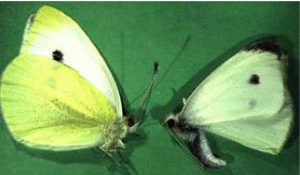
Imported cabbageworm moths. Photo: Courtesy of VegEdge, University of Minnesota

Imported cabbageworm. Photo: Jack Kelly Clark, Courtesy of UC Statewide IPM Program
Beauveria bassiana, the insect-eating fungus, will infect caterpillars if humidity and temperature are adequate. For more information on less-toxic and organically accepted pesticides, go to ATTRA’s Sustainable Pest and Weed Control Database.
Botanical insecticides include neem products (Agroneem™ and Neemix™) that act as repellents, antifeedants, and insect growth regulators. Pyrethrin products are broad spectrum and will kill beneficial insects as well as pests, so monitoring is important. Beneficial insect populations must also be considered when a pest population is present. Many times, the beneficial population may be keeping the pest under the economic threshold, which is the level below economic injury to the crop. An application of a broad-spectrum insecticide may damage both the pest and beneficial insect populations, and other minor pests may become a big problem. This is known as a secondary pest outbreak.
Other management practices to reduce caterpillar infestation include using floating row covers over a young crop to exclude egg-laying females, nocturnal overhead sprinkler irrigation, pheromone misters or emitters to disrupt mating, and pepper, garlic, and herbal repellents.
Some of the control methods mentioned for cabbage looper, diamondback moth, and imported cabbage worm may work on armyworms, cutworms, cabbage webworm, corn earworm, cross-striped cabbageworm, Gulf white cabbageworm, and southern cabbageworm. If the problem is severe, contact your local farm advisor or the ATTRA program.
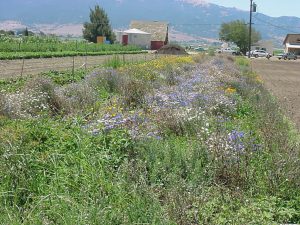
Habitat planting for beneficial insects. Photo: Martin Guerena, NCAT

Cabbage maggot. Photo: Jack Kelly Clark, courtesy of UC Statewide IPM Program
Cabbage Maggot
The cabbage maggot or cabbage fly (Delia redicum) will lay eggs in clusters near the stems of many cole crops or in the debris of a previous cole crop. Once hatched, the larvae bury themselves and start consuming feeder roots, eventually burrowing into the tap root. This provides entry sites for pathogens like clubroot (Plasmodiaphora brassicae). Maggots feed for three to five weeks, then pupate in the roots or in the surrounding soil (Anon., 2003). In Chinese cabbage, eggs laid on the surface of a maturing head hatch maggots that burrow into the head, making it unmarketable. Cabbage flies will have three to four generations per year, starting in the spring through the early autumn in northern areas with cold winters (Hazzard, 2016) to multiple generations in mild-winter production areas like Salinas, California (Joseph and Martinez, 2014).
A study in Denmark demonstrated the susceptibility of cabbage maggot and pupae to Sternernema nematodes (Nielsen, 2003). These insect-eating nematodes are available commercially, and products are listed in ATTRA’s Sustainable Pest and Weed Control Database. Compost and straw mulches significantly reduce the population of root maggots infesting broccoli. The mulch acts as a barrier, preventing the flies from laying eggs directly in the soil. It also serves as a habitat for ground beetle and rove beetle that parasitize and prey on the cabbage maggot (Prasad and Henderson, 2002). Other predators include spiders, harvestmen or daddy longlegs, and ants.
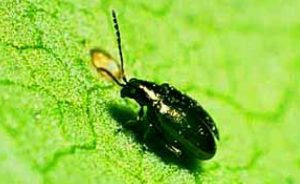
Flea beetle. Photo: Courtesy of Extension Entomology, Texas A&M University
Floating row covers will prevent cabbage flies from depositing eggs during the critical period after plant emergence or transplanting and will also reduce egg-laying on mature Chinese cabbage. Intercropping clovers or other legumes or letting non-brassica weeds fill in the spaces between crop rows will keep root flies from finding open ground near a brassica stem. An experiment in England demonstrated that carboxylic acids (oxalic acid found in rhubarb, acetic acid, or vinegar) are potent inhibitors of egg laying by the cabbage fly (Jones and Finch, 1989). Thus, a solution of crushed rhubarb leaves or a vinegar solution sprayed periodically around cole crop plants may deter the cabbage maggot.
Flea Beetle
The following information is summarized from the ATTRA publication Flea Beetle: Organic Control Options. More detailed information on flea beetles may be found in the above link or by calling ATTRA. Table 2 summarize organic control options.
Symptoms of flea beetle feeding are small, rounded, irregular holes. Heavy feeding makes leaves look as if they have been peppered with fine shot. Further damage may be done by the larvae, which feed on plant roots.
| Cultural Controls | Living mulches or polycultures
|
| Biological Controls |
|
| Chemical Controls |
|
| Source: Kuepper and Dufour, 2015 | |
Diseases
Diseases in plants occur when a pathogen is present, the host is susceptible, and the environment is favorable for the disease to develop. Altering any one of these three factors may prevent the disease from occurring. Organisms responsible for plant diseases include fungi, bacteria, nematodes, and viruses. If these organisms are present, then manipulation of the environment and the host, to make it less susceptible, helps to manage diseases on cole crops more sustainably.
Once again, soil health and management are the key for successful control of plant disease. A soil with adequate organic matter can house uncountable numbers of beneficial organisms such as bacteria, fungi, nematodes, protozoa, arthropods, and earthworms that deter harmful fungi, bacteria, nematodes, and arthropods from attacking plants. These beneficial organisms also help create a healthy plant that is able to resist pest attack.
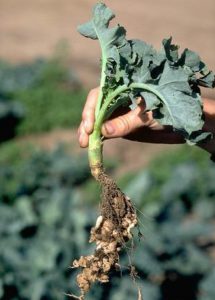
Photo: Jack Kelly Clark, courtesy of UC Statewide IPM Program
Clubroot
Clubroot is caused by the fungus Plasmodiophora brassicae. It infects cole crops through the root hairs or through wounds on larger roots. As the fungus spreads, it distorts and disfigures the roots, causing them to swell and crack, allowing secondary organisms to invade and aid in decay. The disease is favored by acid soils; therefore, liming is recommended if the soil pH is lower than 7.2 (Koike and Subbarao, 2018).
Other methods to control clubroot include rotating out of cole crops for five years, having good drainage, choosing resistant cultivars, and controlling brassica-type weeds. For detailed information on clubroot management, see the publication Integrated Clubroot Management for Brassicas: Nonchemical control strategies in the Further Resources section.

Black leg. Photo: Jack Kelly Clark, courtesy of UC Statewide IPM Program
Black Leg
The fungus Phoma lingam causes black leg of cole crops. The fungus causes yellow-to-tan spots with black specks to form on leaves, and stem cankers form, usually below the soil line. The fungus interferes with water conduction in tissues, wilting and debilitating plants. Seedlings can be killed, and surviving plants may be stunted. The disease can come in with the seed or be present on cole crop debris or brassica-type weeds.
Controls include the use of clean, certified, or hot-water-treated seed, good soil drainage, rotation with non-brassica type crops, control of brassica-type weeds, monitoring and removal of infected leaves, removal or deep incorporation of cole-crop residues, and choice of resistant varieties. To avoid blackleg, it is best to avoid planting near other cole crops or near fields that harbored cole crops during the past season.
Fusarium Yellows
Fusarium yellows are caused by the soilborne fungus Fusarium oxysporum f. conglutinans. Symptoms are yellowing leaves, usually more pronounced on one side of the plant, the loss of lower leaves, curvature of petioles and midribs, and wilting. The ideal temperature range for the development of this disease is 75 to 85°F, with 60°F being the lower limit (Anon., 1987), so it is observed from mid-spring through summer and is not a problem in early plantings. The fungus is persistent in the soil and has many plant hosts, so resistant varieties, good drainage, and soil-building practices such as cover crops and compost are recommended.
Sclerotinia White Rot
The fungi Sclerotinia sclerotiorum and Sclerotinia minor both can cause this rot favored by cool, wet conditions. The fungi have many hosts, including numerous commercial crops and cover crops that fit in a rotation with cole crops, though grasses are not affected. Good drainage and irrigation practices that reduce humidity in fields can help prevent the disease. Deep plowing is often recommended, but the results are temporary and very disruptive to soil microorganisms. Biological controls include the fungus Coniothyrium minitans, which parasitizes sclerotia (resting bodies) of the plant pathogen. Products with Coniothyrium minitans can be found in ATTRA’s Sustainable Pest and Weed Control Database.

Black rot. Photo: Courtesy of Meg McGrath, Cornell University
Black Rot
Black rot is caused by the bacterium Xanthomonas campestris. This bacterium favors humid, rainy conditions, and is dispersed by the splashing of water droplets. Xanthomonas enters the plant at leaf margins or through wounds. Leaf margins develop yellowish patches that turn brown with black veins. The infection works its way down the leaves, leaving a “V” pattern in its wake. The pathogen may eventually invade the vascular system, spreading throughout the plant. Controls include rotation, weed control, thorough debris incorporation, use of clean seed, and application of approved copper products and other biorational pesticides found in ATTRA’s Sustainable Pest and Weed Control Database.

Downy mildew. Photo: Gerald Holmes, Cal Poly San Luis Obispo, Bugwood.org
Downy Mildew
Downy mildew is a disease caused by the fungus Hyaloperonospora brassicae (formerly known as Peronospora parasitica). Infection and development are favored by cool, wet weather, and the fungus attacks cole crops at all stages of growth. Once Hyaloperonospora invades a plant, it consumes the contents of the plant’s cells and then sporulates, sending sporangia out to form cottony white masses, usually under leaves. The tops of leaves develop purplish spots that later turn yellow or brown. These spots correspond to the sporulating areas on the undersurfaces of the leaves. Infected young seedlings may die, while cauliflower curd, broccoli florets, radish roots, and cabbage heads may all become unmarketable. Management includes promoting good drainage, increasing spacing for better aeration, controlling brassica-type weeds, using resistant varieties, rotating with non-cole crops, incorporating plant debris, and avoiding the use of overhead irrigation.
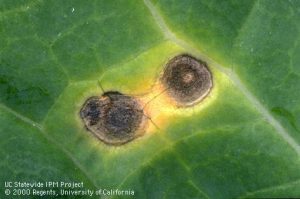
Alternaria leaf spot. Photo: Jack Kelly Clark, courtesy of UC Statewide IPM Program
Alternaria Leaf Spot
This disease is caused by the fungi Alternaria brassicae and/or A. brassicola. Small, dark spots initially form on leaves, but later develop into tan spots with target-like concentric rings. When dried, these spots fall from the leaves, resulting in a “shot-hole” effect. Prolonged periods of high humidity, cool temperature, and rain favor its development. Infected cabbage heads will have spots on several leaves, and Brussels sprout buds will have several layers infected. It discolors broccoli and cauliflower heads, and Chinese cabbages are more susceptible than other cole crops.
Management practices include using clean, certified seed, rotating with non-host crops, deeply incorporating plant debris, avoiding overhead irrigation, and promoting air circulation in the canopy.
Physiological Disorders
Tipburn is the browning of internal leaf edges or tips within the heads of cabbage, Brussels sprouts, and cauliflower. These brown spots tend to break down during storage or transport, allowing secondary organisms to decay the product. The problem is related to rapid growth caused by excessive nitrogen, high temperature, water stress, and calcium deficiency. Calcium can be present in the soil but its translocation to the plant is limited, and it may not be available to accommodate rapid growth. Supplemental nitrogen applications should be timed to avoid rapid growth in the later stages of plant development.
Riceyness of cauliflower causes the curds to become uneven and fuzzy, reducing marketability. Warm temperatures (> 80°F) during head development are the cause of this disorder (Koike et al., 2009).
Hollow stem in broccoli and other cole crops is caused by rapid growth, usually due to excessive nitrogen levels and high temperatures. The plant stem experiences rapid growth, and the core or pith cracks, leaving the stem hollow. Another factor that contributes to this disorder is plant spacing. The closer the plant spacing, the less likely this phenomenon will occur.
Buttoning of broccoli and cauliflower occurs when immature plants are exposed to consistently low temperatures for a prolonged period. This stimulates the young plants to produce reproductive structures—the flower buds and curd—and small, loose heads are formed.
Bolting is caused by many factors and depends on the crop and the varieties grown. Stress caused by too much or too little water, transplant shock, day lengths of more than 12 hours, and low temperatures during the early stages of development are all contributing factors.
Weeds
There are many Brassicaceae weeds that are troublesome in cole crop plantings because they compete for water, nutrients, and light, and they harbor insects and diseases that can affect the crop. Table 3 lists many of these weeds and includes both their common and scientific names.
Weed control in organic systems, especially in vegetable production, relies heavily on crop rotations, cover crops, and cultivation. Of these, cultivation is the most critical to reduce weeds in an established cole-crop stand. For cultivation to be successful, a straight, well-made bed, as well as straight seeding or transplant lines, is necessary in order for cultivating implements to remove most weeds while leaving the crop undisturbed. Cultivation implements will cut, bury, or turn over most young weeds, without disturbing the crop, leaving it with reduced competition. In California, it usually takes two cultivations before a young cole crop starts to out-compete weeds. Hand hoeing may be necessary after the first cultivation to reduce weeds in the plant line. If the crop is direct-seeded, weeding and thinning take place after the first cultivation.
Harvesting
Cabbages are harvested when the heads are firm and solid. Sizes may vary, but firmness is the determining factor. If solid heads are left too long in the field to size up, they may crack or split. Cabbages should be sorted, packed, and stored according to size.
Cauliflower heads with white firm curds six to eight inches in diameter are what consumers prefer. Blanching, or tying the outer leaves, is done with certain varieties when the heads are about three to four inches in diameter, to keep sunlight from yellowing the curds. Curds should be handled carefully because they bruise easily and will develop discolored patches on these bruises. The surrounding trimmed leaves should be kept on the head for handling purposes to protect the curd. Some operations field-wrap the trimmed curds in cellophane or plastic bags before cooling and storing them in refrigeration.
Broccoli is harvested when most heads are tight, five to seven inches in diameter, and of a blue-green color. They are cut with a 6-inch stem. If left in the field, heads tend to loosen and expand, reducing quality. Fields should be harvested every three days, due to the rapid growth of this crop. Once the head is harvested, side shoots may develop from lateral axils on the stem, producing smaller inflorescences that may also be marketed.
Brussels sprouts produce many small buds in leaf axils along the entire stem. The lowest sprouts on the stem are picked first, along with the leaves, and harvest progresses upward as the other sprouts mature. Sprouts may crack if left on the stem too long.
Kale and collards are harvested leaves with petioles and are usually bunched together with a wire tie. Bunches are typically about eight to 14 inches long.
Kohlrabi should be harvested when the swollen stem is two to three inches in diameter. There are green and purple varieties. If left in the field for too long, the swollen stem becomes woody.
Chinese cabbage heads should feel solid and not collapse when pressed firmly with both hands. The wrapper leaves surrounding the cabbage should be stripped to leave only a couple to cover the firm head.
Pak choi can be harvested a few leaves at a time, cutting the outer leaves when they reach a desired size, or by harvesting the whole head. Some varieties are very brittle and should be left to wilt slightly to avoid breaking before packing.
Postharvest
Once a cole crop is harvested, it continues its biological processes until it deteriorates to an unsaleable product. The key to successful postharvest handling is to delay these processes in order to get the product to the consumer in the best condition possible. Temperature is the most important factor affecting harvested produce. It directly affects the rates of all vital processes: respiration, ripening, moisture loss, and the development and spread of decaying organisms. The higher the temperature, the faster these processes occur. Therefore, proper temperature management is important throughout the supply chain, from harvesting to consumption. The sooner the field heat is removed from the product, the longer it will last, giving the producer more time to sell the product.
Cooling methods vary according to the commodity; the most common are cold rooms, forced air cooling, hydrocooling, and icing. Cold rooms are places where products in containers can be kept under refrigeration. The less field heat accumulated in the product, the quicker this system will cool the product.
Forced-air cooling is done in a cold room and requires containers with vents so that the cold air can flow through. The containers are stacked in rows placed on either side of a fan, leaving an aisle between the rows. The aisle and the open end are covered with a tarp to create a tunnel. The fan draws air from outside the tunnel through the openings in the containers, forcing cold air around the warm product.
Hydrocooling uses cold water to cool commodities rapidly. Containers must be waterproof and allow water to enter and pass over the product. Cartons or lugs are either submerged in cold water or showered from above with recirculated cold water.
Icing consists of placing ice on the product in the container. This is usually done with broccoli, Brussels sprouts, and turnips. All brassica crops last the longest when stored at 32°F, just above the freezing point (Hardenburg et al., 1986).
Economics and Marketing
The economics of growing cole crops vary enormously from crop to crop and in different regions. The budget below was developed for growing organic broccoli in the Carolinas by the Carolina Farm Stewardship Association (CFSA). This budget is intended as a reference to help farmers develop their own budgets based on local conditions.
Large and some medium producers market their products to wholesalers, brokers, and terminal markets. These marketing options are not advantageous for some medium and smaller growers because of low returns, uncertainty of prices, risk of rejection, and strict packing standards and food safety regulations. Alternative markets exist for smaller producers, such as marketing directly to consumers through farmers’ markets, community supported agriculture (CSA), and roadside stands. Direct sales to restaurants and small, independent grocers are other choices. For more information on alternative marketing, see ATTRA’s Business and Marketing topic area.
Summary
The number of crops in the brassica family, their nutritional qualities, health benefits, compatibility in planting rotations, and pest-suppressive qualities make these crops an excellent choice for any organic farmer. They grow in all regions in different seasons and add diversity to a farmer’s income and products.
Cole Crops and Other Brassicas: Organic Production
By Martin Guerena, NCAT Agriculture Specialist
Published 2006, updated May 2020
© NCAT
IP275
Slot 275
This publication is produced by the National Center for Appropriate Technology through the ATTRA Sustainable Agriculture program, under a cooperative agreement with USDA Rural Development. ATTRA.NCAT.ORG

